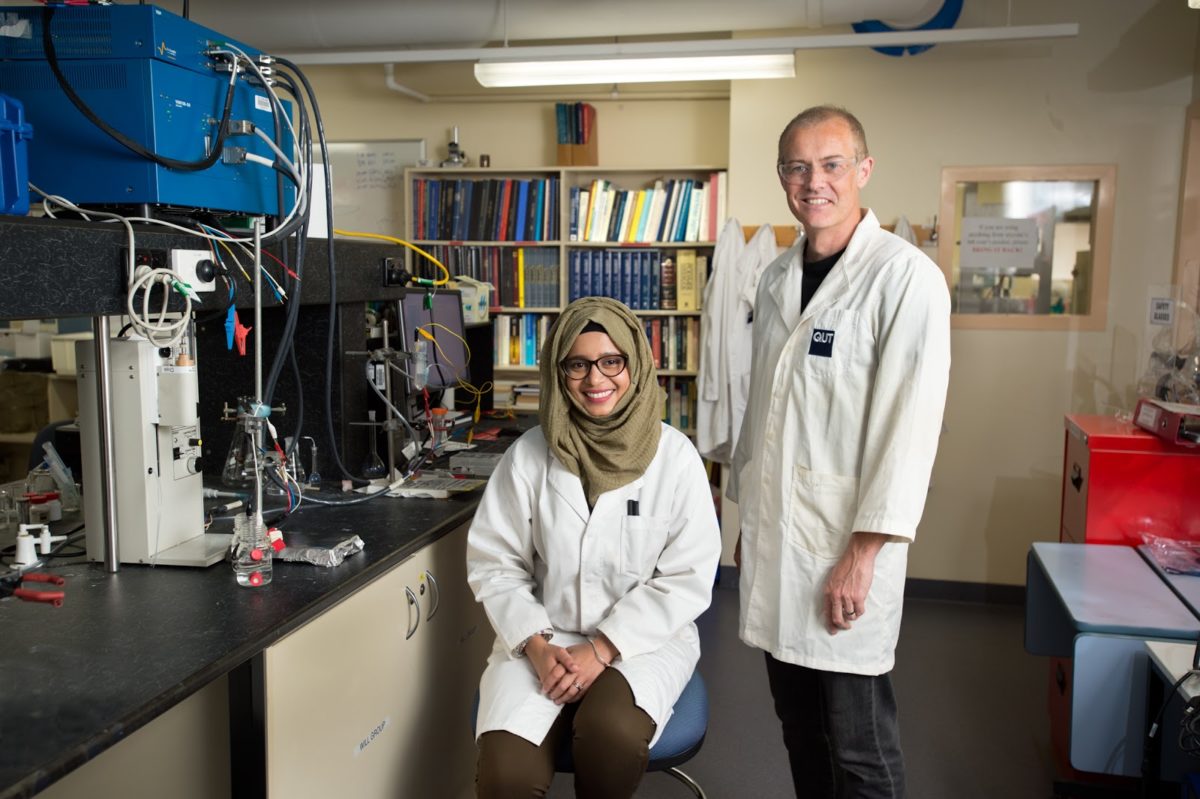QUT Professor Anthony O’Mullane and PhD student Ummul Sultana have demonstrated the efficiency of a cobalt-nickel-gold system for electrochemical production of hydrogen, which could replace expensive, currently used materials.
The International Energy Agency estimates the global market for hydrogen will reach US$155 billion by 2022. Australia, with its technically skilled workforce in the energy sector and extensive renewable-energy resources, is well placed to take advantage of such a boom, and simultaneously reduce its own carbon emissions in two major emitting sectors – electricity production and transport.
“In principle, hydrogen offers a way to store clean energy at a scale that is required to make the rollout of large-scale solar and wind farms as well as the export of green energy viable,” says O’Mullane, from QUT’s School of Chemistry, Physics and Mechanical Engineering.
“However,” he adds, “current methods that use carbon sources to produce hydrogen emit carbon dioxide, a greenhouse gas that mitigates the benefits of using renewable energy” in other parts of the economy.
The most mature and least expensive methods of hydrogen production currently under development are thermochemical, using fossil fuels or natural gas to produce hydrogen; but development of electrochemical processes, using low-cost, low- or zero-emissions energy is catching up, according to the recent CSIRO National Hydrogen Roadmap.
Modelling undertaken by the CSIRO shows commercial thermochemical hydrogen production coming online in the 2030s at a cost of $2.14 – $2.74/kg; while favourable contracts for low-emission electricity could bring electrochemical demonstration projects to the market at $2.29 – $2.79/kg by 2025.
O’Mullane and Sultana’s work is part of a world-wide drive to advance the renewably powered electrochemical contenders to supremacy. Australia this year also saw a breakthrough in the work of Curtin University researchers using nanocrystals to convert solar energy into hydrogen.
Traditionally, catalysts for splitting water into its hydrogen and oxygen molecules, “involve expensive precious metals such as iridium oxide, ruthenium oxide and platinum,” says O’Mullane. And, he says the evolution of oxygen as part of the reaction is not always stable, which can limit the efficiency of the process.
The process he has tested in collaboration with Sultana uses “two earth-abundant cheaper alternatives, cobalt and nickel oxide, with only a fraction of gold nanoparticles” – which boost efficiency of the catalyst – “to create a stable, bi-functional catalyst” that splits water and produces hydrogen without emissions.
At the moment, he says, the two reactions are typically each enabled by different catalytic materials. “Our material, the cobalt-nickel-gold system, can do both reactions – hydrogen on the one side and oxygen the other. It makes manufacturing the electrolyser a lot simpler.”
Stored hydrogen can be used in fuel cells for transport, or to feed energy back into the grid when required during peak demand, says O’Mullane.
CSIRO identifies hydrogen-fuelled transport as an early target market in the development of an Australian hydrogen industry, but says “vehicle uptake will need to be stimulated in Australia through implementation of vehicle emissions standards and/or specific incentives”.
The National Hydrogen Roadmap says hydrogen systems are also capable of providing electricity grid stability — flexible load that can be ramped up and down as needed – but their principal application for grid firming is as storage, to capture seasonal abundance of variable renewable energy and return it to the grid at times of lower seasonal availability.
The QUT team’s discovery has been published in the journal Advanced Functional Materials, under the title Gold Doping in a Layered Co-Ni Hydroxide System via Galvanic Replacement for Overall Electrochemical Water Splitting. In 2019, O’Mullane will work on scaling the process, “building electrolysers to produce hydrogen at a reasonable scale” that confirms commercial application.
Natalie Filatoff
This content is protected by copyright and may not be reused. If you want to cooperate with us and would like to reuse some of our content, please contact: editors@pv-magazine.com.








It is wonderful that they have found a way to store hydrogen in a stable form using solar energy & sea water, has this been patented worldwide or is to be sold to a multinational to exploit us, ? also what percentage of the liquid is recovered as hydrogen gas ? ie. is there any residue or waste ?